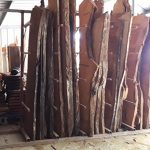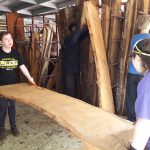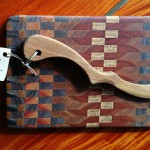Learning by Doing
From 2003 to 2014, we harvested our first trees. Hibiscus elatus, otherwise known commonly as Majo Azul or Blue Mahoe. Selected from around the homestead and road, to thin out the canopy, and to cut out damaged or deformed trees. The wood was milled on a portable Ross Bandmill and from 2013, on a Cook’s Portable Sawmill. The wood was stacked and dried, and marketing and sales continue over the years. Much of this was carried out without any previous experience, and was a great lesson in learning by doing. In 2006, we collaborated with US Forest Service Firefighters who wanted to carry out a chain-sawing workshop. They participated in selective harvesting of mahoe trees, and Andrés Rúa had the benefit of being trained in directional felling, a skill that has been truly valuable to this project. Thrity Vakil and Andrés continued to directionally fell trees, mill and market them, working with groups of volunteers from all over the world.
 Mahoe, (Hibiscus elatus), was the first timber tree being harvested from 15 to 35-year-old plantations at Las Casas de la Selva. Known as “Blue Mahoe” for the characteristic coloration of its wood, Mahoe is native to Jamaica and Cuba. It can grow to 25m tall and upwards of 100 cm DBH (KIMBER, 1970). It is characteristic of open disturbed habitats, and as an understory tree in secondary forests because it is shade-tolerant. Mahoe was recognized as a potentially important species for plantation and forest enrichment after a survey by Jamaican foresters (LONG, 1963 cited in KIMBER, 1970). It is an excellent wood with a rich variety of colors and attractive grain, but surprisingly, very little Mahoe is currently being produced anywhere else. The first plantings in Puerto Rico were in the 1940s, and it has been introduced to other Caribbean islands and Hawaii for evaluation. It has become naturalized in Mexico, Peru, Brazil, southern Florida and the West Indies (CHUDNOFF, 1982 cited in WEAVER, FRANCIS, n.d.)
Mahoe, (Hibiscus elatus), was the first timber tree being harvested from 15 to 35-year-old plantations at Las Casas de la Selva. Known as “Blue Mahoe” for the characteristic coloration of its wood, Mahoe is native to Jamaica and Cuba. It can grow to 25m tall and upwards of 100 cm DBH (KIMBER, 1970). It is characteristic of open disturbed habitats, and as an understory tree in secondary forests because it is shade-tolerant. Mahoe was recognized as a potentially important species for plantation and forest enrichment after a survey by Jamaican foresters (LONG, 1963 cited in KIMBER, 1970). It is an excellent wood with a rich variety of colors and attractive grain, but surprisingly, very little Mahoe is currently being produced anywhere else. The first plantings in Puerto Rico were in the 1940s, and it has been introduced to other Caribbean islands and Hawaii for evaluation. It has become naturalized in Mexico, Peru, Brazil, southern Florida and the West Indies (CHUDNOFF, 1982 cited in WEAVER, FRANCIS, n.d.)






